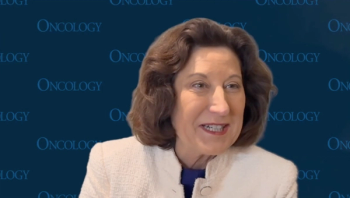
ctDNA May Play Role in Large Cell Lymphoma Detection
Data from previous studies demonstrate that pretreatment levels of circulating tumor DNA may be prognostic in diffuse large B-cell lymphoma, according to Mark J. Roschewski, MD.
The use of circulating tumor DNA (ctDNA) may supplement imaging scans, effectively aiding in detecting active large cell lymphoma in patients near the end of treatment, according to Mark J. Roschewski, MD in a presentation at the
“It is clear that you can detect disease in many cases below imaging scans, other [hematologic] malignancies use this, solid tumors use this, [but] in lymphoma we are way behind, for multiple reasons,” Roschewski, from the Lymphoid Malignancies Branch, Center for Cancer Research, National Cancer Institute, said during his presentation. “At the end of therapy, there is enhanced analytics sensitivity. In my view, this enhances our response criteria.”
Currently, CT/PET scans are primarily used for staging, response assessment, and surveillance, Roschewski noted. These modalities have several limitations, particularly when it comes to detecting MRD. “You cannot detect disease at the molecular level with imaging, it’s not possible,” he said. Circulating tumor DNA is appealing as an alternative, since it relies on a peripheral blood followed by DNA extraction using a kit.
There are several advantages, outside of the minimal invasive nature of blood collection for ctDNA, Roschewski noted. The lower limit of detection is magnitudes below imaging and it has the potential to be specific for nearly every tumor. It also provides a quantitative metric, whereas scans are typically more qualitative, he added. These benefits are not without drawbacks. There is non-tumor DNA also circulating in the blood, which can confound the assessment. There may also be a very low quantity of ctDNA, making it "like finding a needle in a haystack,” Roschewski said.
Focusing on large cell lymphoma, specifically diffuse large B-cell lymphoma (DLBCL), Roschewski noted that previous studies have shown that pretreatment levels of ctDNA are prognostic.2 Moreover, he added, this was not just a proxy for disease burden and that ctDNA was able to detect early molecular response, which translated to improved outcomes. “If you look at the multivariate analysis, this was more prognostic than tumor burden and other things we would think might be prognostic. It is giving more information than just how big the tumor is,” he said.
In this study,2 ctDNA was detectable in 98% of patients and was shown to be prognostic for both frontline and salvage therapy. The ctDNA levels could effectively detect early molecular response after the first cycle of treatment, defined as a 2-log decrease in ctDNA, and then a major molecular response after the second cycle, a 2.5-log decrease. Those with these molecularly defined responses were significantly more likely to experience event-free survival (EFS) at 24 months. For those with any early response, the EFS was 83% compared with 50% for those without (P = .0015). For those with a major response, the EFS was 82% compared with 46% for those without (P <.001).
“This analyte can be useful in multiple contexts, and I am only talking about progressive lymphomas right now, where our goal is to cure,” said Roschewski.
PET scans conducted at the conclusion of therapy do have some prognostic value, he added. In the GOYA study (NCT01287741) of patients with DLBCL,3 with a median follow-up of 47.7 months, the positive-predictive value (PPV) for progression-free survival was 48.8% for patients without an end of treatment FDG PET/CT defined complete response. The negative predictive value (NPV) was 83.5%. The PPV for OS was 43.2% without a PET CR and the NPV was 92.9%.
“This is not discriminating perfectly. If you have a positive PET scan, your chance of progressing in the next 2 years is under 50%,” said Roschewski. “This is the type of thing that leads us all to do additional tests. If we use this information and they go on to salvage therapy, what is going to happen? We might be treating a bunch of patients that might already be cured, because this is the best test we have to tell if you’re in remission.”
Several previous ctDNA-based assays have been explored to identify MRD at the end of treatment, but these have not led to practice-changing results. Roschewski noted, the PhasED-Seq, which he helped develop, may overcome some of the obstacles faced by prior tests. The PhasED-Seq test looks for phased variants, which are different somatic mutations on the same DNA molecule.
“Statistically speaking, if you’re finding phased variants, if there’s more than 1 genomic mutation on the same cell-free DNA molecular, it must be tumor, statistically speaking,” he said. “This is a way to improve sensitivity and allows you to go deeper, in this case, 100 times deeper, and you can be more certain at the end of that time point that you’re actually measuring tumor.”
Data on PhaseEd-Seq MRD detection in large cell lymphoma were presented at the International Conference on Malignant Lymphoma from pooled data from 6 studies.4 In this analysis, 151 samples were evaluable for analysis with genotyping successfully completed in 97%. MRD at the end of treatment was detected in 93 patients, and indicated the highest level of risk, with an HR of 84 (P <.0001). Persistent MRD at the end of treatment by PhaseEd-Seq showed a 90% sensitivity for identifying PFS with up to 30 months of follow up. Moreover, 97% of those with undetectable MRD at the end of treatment by PhaseEd-Seq remained progression-free at a median of 17 months.
Both PET/CT and MRD by PhaseEd-Seq at the end of therapy were found to be prognostic in this study; however, Roschewski noted, MRD performed much better. In patients with CR by PET/CT, MRD was able to further classify the probability of a PFS event (P <.0001). Of the 75 patients with a CR by PET/CT, MRD was detected in 13, with a subsequent PFS event occurring.
“Some of these events were happening 2 to 3 years later,” said Roschewski. “This shows us the potential analytical sensitivity of these data.”
References
- Roschewski, Mark J. Circulating Tumor DNA in Lymphoma: When Will This Be Ready for Prime Time? Presented at: 11th Annual Meeting of the Society Hematologic Oncology (SOHO 2023), September 6, 2023. Houston, TX.
- Kurtz DM, Sherer F, Jin MC, et al. Circulating tumor DNA measurements as early outcome predictors in diffuse large B-cell lymphoma. J Clin Oncol. 2018;36(28):2845-2853. doi: 10.1200/JCO.2018.78.5246.
- Kostakoglu L, Martelli M, Sehn LH, et al. End-of-treatment PET/CT predicts PFS and OS in DLBCL after first-line treatment: results from GOYA. Blood Adv. 2021;5(5):1283-1290. doi:10.1182/bloodadvances.2020002690.
- Roschewski M, Kurtz DM, Westin J, et al. MRD-negativity after frontline DLBCL therapy: pooled analysis of 6 clinical trials. Hematol Oncol. 2023;41(S2):177-179. doi:10.1002/hon.3163_112.
Newsletter
Stay up to date on recent advances in the multidisciplinary approach to cancer.

















































































